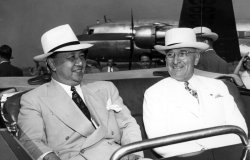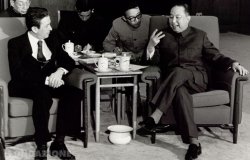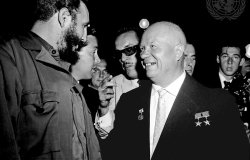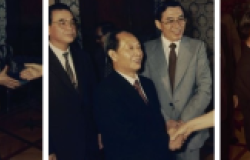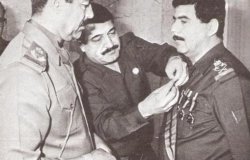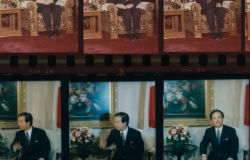
A blog of the History and Public Policy Program
Security for Disarmament: Negotiating Ukraine’s Budapest Memorandum
Mariana Budjeryn introduces a new batch of translated Ukrainian documents to mark the 24th anniversary of the Budapest Memorandum.

Shutterstock.com
The ongoing Russian-Ukrainian conflict, with its recent escalation in the Sea of Azov, continues to draw attention to the substance of security commitments pledged by the nuclear weapons states to Ukraine in exchange for dismantling the nuclear arsenal it inherited from the Soviet Union.
On December 5, 1994, Ukraine, the Russian Federation, the United States, and the United Kingdom signed the Memorandum on Security Assurances in Connection with Ukraine’s Accession to the Treaty on the Non-Proliferation of Nuclear Weapons in Budapest, Hungary—the letter and spirit of which has been the focus of a renewed public and academic discussion since its violation by Russian in 2014.
An Issue Brief revisiting the history of the Budapest Memorandum negotiations was published by the Nuclear Proliferation International History Project (NPIHP) in 2014 along with a collection of translated Ukrainian archival documents. On the 24th anniversary of the signature of the Budapest Memorandum, NPIHP is now releasing a new batch of translated Ukrainian documents to augment the existing collection.
The new documents elucidate the challenges faced by Ukraine in 1992-1993 in a two-track negotiation process on nuclear disarmament. One track was the negotiation of security guarantees where it engaged primarily with the United States but also with Russia. The documents (here, here, and here) reveal that Ukraine’s diplomats mounted an earnest, although ultimately unsuccessful, effort to negotiate robust security commitment from the United States in a legally binding format.
The second track was the negotiation with Russia of the compensation for the fissile materials contained in the nuclear warheads withdrawn from Ukraine, as well as of the procedure for regular servicing of nuclear warheads by Russian manufacturers to ensure their safety while they were still on Ukraine’s territory.
The documents (here and here) show that the Ukrainian leadership was concerned about the safety of nuclear warheads on its territory in view of Ukraine’s dependence on Russia’s technical servicing and maintenance of the warheads, a leverage Russia might have used to its advantage. The documents also reveal (here, here, and here) the critical divergence in Russian and Ukrainian positions regarding the matter of ‘ownership’ of nuclear warheads in Ukraine and their components, not only as a basis for compensating Ukraine for the fissile materials contained in the warheads, but also as a matter of principle.
The documents include:
- LetterN-15/44-23403 from the Ministry of Foreign Affairs of Ukraine to the Ministry of Foreign Affairs of the Russian Federation regarding the opening of negotiations, December 28, 1992, Archive of the Ministry of Foreign Affairs of Ukraine, Fond 1, Delo 7063.
- Deputy Minister of Foreign Affairs B.I. Tarasiuk, “Report on the results of the Ukrainian-American political consultations,” January 8, 1993, Archive of the Ministry of Foreign Affairs of Ukraine, Fond 1, Delo 7061.
- Speech by Y.I. Kostenko, at the opening of negotiations with the Russian Federation on the elimination of nuclear weapons in Irpin’, January 26, 1993, Archive of the Ministry of Foreign Affairs of Ukraine, Fond 1, Delo 7063.
- Statement by Leonid M. Kravchuk, President of Ukraine, at the World Economic Forum in Davos, 30 January, 1993: “How to Prevent the Proliferation of Nuclear Weapons,” February 18, 1993, Archive of the Ministry of Foreign Affairs of Ukraine, Fond 1, Delo 7057.
- Report of Ukraine’s Ministry of Foreign Affairs “On Comprehensive Solution of a Wide Range of Issue related to the Strategic Nuclear Weapons deployed on the territory of Ukraine and Tactical Nuclear Warheads removed from Ukraine for Dismantlement and Elimination,” March, 1993, Archive of the Ministry of Foreign Affairs of Ukraine, Fond 1, Delo 7057.
- Letter of Russian President B. Yeltsin to Ukrainian President L. Kravchuk regarding negotiations on nuclear disarmament, April 30, 1993, Archive of the Ministry of Foreign Affairs of Ukraine, Fond 1, Delo 7063.
- Draft Statement of the Russian Federation on Security Guarantees to Ukraine, nd. [July?] 1993, State Archive of the Russian Federation, Fond 10026, Opis 4, Delo 1279.
- Letter of Foreign Minister A.M. Zlenko to Prime-Minister L.D. Kuchma regarding the status of Ukrainian-Russian negotiations on nuclear disarmament, July 22, 1993, Archive of the Ministry of Foreign Affairs of Ukraine, Fond 1, Delo 7063.
About the Author

Mariana Budjeryn
Senior Research Associate, Project on Managing the Atom at the Harvard Kennedy School’s Belfer Center

History and Public Policy Program
The History and Public Policy Program makes public the primary source record of 20th and 21st century international history from repositories around the world, facilitates scholarship based on those records, and uses these materials to provide context for classroom, public, and policy debates on global affairs. Read more

Nuclear Proliferation International History Project
The Nuclear Proliferation International History Project is a global network of individuals and institutions engaged in the study of international nuclear history through archival documents, oral history interviews, and other empirical sources. At the Wilson Center, it is part of the Wilson Center's History and Public Policy Program. Read more

Cold War International History Project
The Cold War International History Project supports the full and prompt release of historical materials by governments on all sides of the Cold War. Through an award winning Digital Archive, the Project allows scholars, journalists, students, and the interested public to reassess the Cold War and its many contemporary legacies. It is part of the Wilson Center's History and Public Policy Program. Read more
